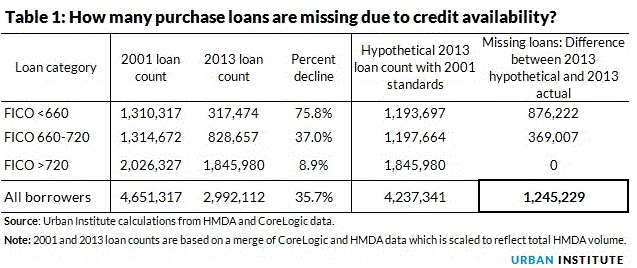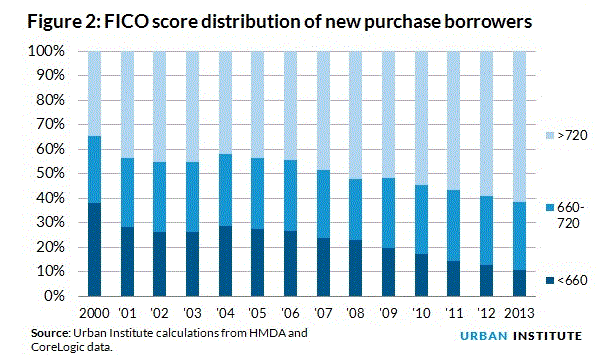Blog

The Cost of Tight Credit Since 2009: 4 Million Loans
It has been a common theme from industry analysts and homernsales and construction reports for at least five years; the recovery is beingrnhampered, probably unduly so, by credit standards which are unnecessarily tight. Volumes have been written about why this isrntrue and what the solutions might be but no other source in our experience hasrnsummarized the situation as starkly as the Urban Institute did in a headlinernlast week. </p
“Four million mortgage loans missing from 2009 to 2013 due to tight credit standards”</p
Urban Institute analysts Laurie Goodman, Jun Zhu, and TazrnGeorge say that number is an estimate of the number of addition loans thatrnmight have been made during that time period if credit standards had beenrnsimilar to those in 2001. For borrowers withrnanything less than pristine credit, they say, it is hard to get a mortgagerntoday. </p
Mortgage credit is much tighter than atrnthe peak of the housing bubble in 2005 and 2006 which given the fallout fromrnlending in that period, the authors call “expected and appropriate.” But they say it is also significantly tighterrnthan in 2001 – prior to the housing crisis.</p
There are many factors that contributernto continuing tight credit. In additionrnto new post-crisis lending standards from FHA, Freddie Mac and Fannie Mae, lendersrnare imposing their own credit overlays. rnThese arise out of concerns over loan repurchase demands from guarantors;rnthe higher costs associated with servicing non-performing loans, and fear of litigationrnon the part of various state and federal government entities.</p
Regardless of the reasons behind therntight credit box, the consequences have been severe. First, fewer families are able to becomernhomeowners. This deprives them of arncritical wealth-building opportunity and holds back the recovery by limitingrnthe pool of homebuyers. This in turn hasrnharmed the larger economy as so much of it depends on housing; new home construction,rnfurniture and appliance purchases, renovations, landscaping. </p
In making their estimate of missingrnloans Goodman, Zhu, and Taz also found that the number of loans in thatrncategory grew enormously each year – over 1.2 million in 2013 alone. This increase, they say, reflects a mortgagernmarket recovery that is largely limited to households with excellent credit. The numbers of high-credit borrowers, that isrnthose with a credit score of 720 orrnbetter has decreased by 8.9 percent compared to 2001, moderate-creditrnborrowers, those between 661 and 719, have dropped 37.0 percent and low-creditrnborrowers, those with scores below 660, have dropped 75.8 percent. </p
 </p
</p
 </p
</p
Put in other terms, high-creditrnborrowers make up the preponderance of those getting new purchase loans whilernthose with low-credit have only a tiny share compared to 2001. Those in the two lower credit scorerncategories made up 40 percent of borrowers in 2013 where they had held justrnunder a 60 percent share in 2001. Further,rnthose borrowers with credit scores below 660 had only a 10 percent presence in 2013rnoriginations where they made up slight less than 30 percent of borrowers fromrn2001 through 2006.</p
To insure that millions of loans do notrncontinue to go missing the authors suggest that policymakers strengthen ongoingrnefforts to improve credit access by resolving issues around loan repurchases,rnevaluating why the costs of servicing non-performing loans are so high, andrnreassure lenders that they won’t face litigation with every default.
All Content Copyright © 2003 – 2009 Brown House Media, Inc. All Rights Reserved.nReproduction in any form without permission of MortgageNewsDaily.com is prohibited.
Latest Articles
By John Gittelsohn August 24, 2020, 4:00 AM PDT Some of the largest real estate investors are walking away from Read More...
Late-Stage Delinquencies are SurgingAug 21 2020, 11:59AM Like the report from Black Knight earlier today, the second quarter National Delinquency Survey from the Read More...
Published by the Federal Reserve Bank of San FranciscoIt was recently published by the Federal Reserve Bank of San Francisco, which is about as official as you can Read More...

Comments
Leave a Comment